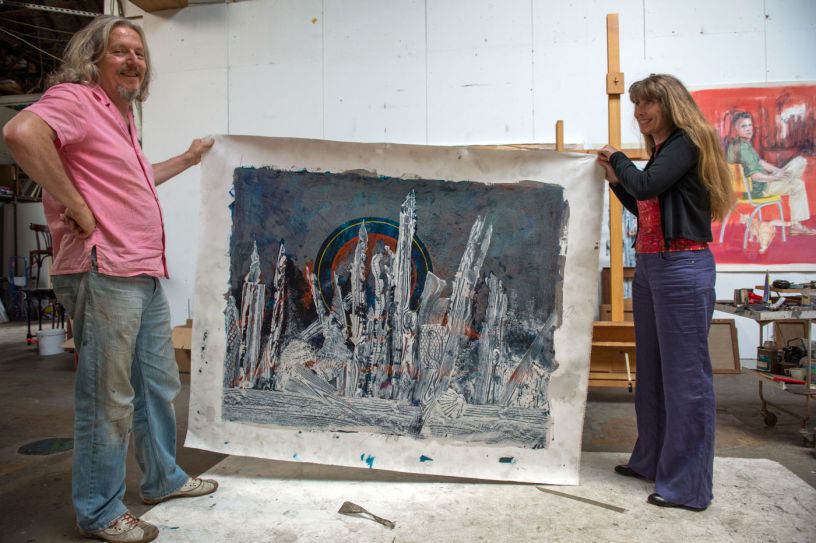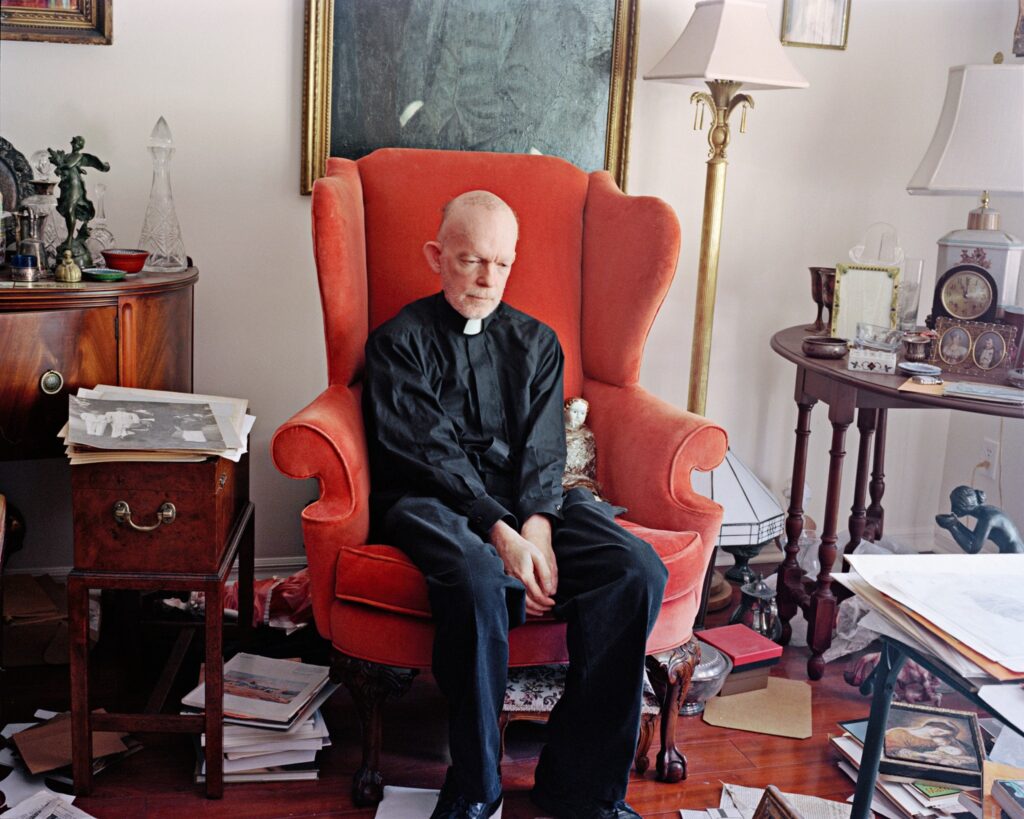A look inside some of the greatest art-world scams of the last 40 years
Imagine the scene:
A young man makes his way home across the sun-drenched beaches of a far-flung Pacific Island, his curly auburn hair glistening in the sun. Arriving home, he stops to feed a stray dog meandering outside of his island abode – waves crash in the distance.
Pleased with his good deed for the day, he turns the key of his front door and is rewarded with the icy blast of air conditioning. Time to relax. He puts on a pot of coffee, turns on the television and kicks off his sand-filled shoes. CNN plays on a dated flatscreen in the living room – his face is all over the news, staring right back at him. “Meet the most wanted man in art!” exclaims the newscaster emphatically. He stares blankly back, clutching remote and nervously sighs – how did he get here…where did it go so wrong?
Moments later as the sun sets over the palm speckled skyline, the FBI are at his door. He has been found.
It’s a tale fit for a paperback novel, yet this is the true story of the latest scandal to rock the art world. The protagonist, Inigo Philbrick, a high educated Connecticut-born 33 year old man who managed to rustle some $20 million out of his high profile clients and friends around the world. A week ago, he was captured living on the remote island of Guam where he had been hiding since defaulting on $14M of loans in October 2019.

Among Philbrick’s many – alleged – misdeeds, he managed to sell paintings by Christopher Wool, Basquiat and Stingel many times over to multiple buyers, he borrowed money against and sold paintings he never owned, stole another buyer’s identity and forged countless documents to hide his tracks. Saudi princes, high-flying art collectors and members of the international glitterati were all victims.
Nevertheless, Inigo Philbrick’s Dickensian name aside, he is no anomaly within the often spurious world of art. Throughout the ages there have been innumerable fraudsters, hucksters and con men and women that have prayed on the art appetites of the wealthy.
We take a moment to step through time and explore some of the greatest cheats of the art business:

Wolfgang & Helene Beltracchi
The married German art-forging, wunder duo of Wolfgang & Helene pulled the rug under the art world for decades. Wolfgang would paint meticulously crafted fakes (down to the chemical composition of the labels) whilst his wife would hawk the paintings to a select group of dealers and galleries. The pair made millions as their paintings sold at high-profile auctions in NY, Europe and London.
So confident were they that they invited detractors that questioned the authenticity of their works to carefully examine the paintings. One auction house even brought along Max Ernst’s widow to identify a painting supposedly by Ernst – which she subsequently verified as genuine. It seemed they were the “teflon dons” of the art community – no one could pin down whether they were up to no good.
Unfortunately for the Beltracchi’s, however, hubris got the better of them and ol’ Wolfy made a mistake on his copy of Dutch painter Heinrich Campendonk’s Red Picture With Horses. Having used an incorrect white paint pigment that was anachronistic with the original’s timeline finally proved that a picture they sold was a forgery and it landed Wolfgang in prison.
Upon release in 2015 – the Beltracchis were met with an onslaught of media, igniting an interest in works under Wolfgang’s own name and prompting him to brag that there were at least 300 other forged works by him hanging in museums all over the world. What a peach.

Glafira Rosales
One day in the mid-1990’s, a woman walks into the oldest and most respected gallery in New York City – the Knoedler Gallery. She claims to have a previously unseen inventory of masterpieces owned by a man that goes by the name of “Mr. X”. The collection purportedly included paintings by Rothko and Pollock that were (even then) worth tens of millions.
Unbelievably, the gallery’s director Ann Freedman seemed to have no qualms about this mystery collection and happily agreed to sell the works through Knoedler. High-profile figures like Italian businessman Domenico de Sole (a Sotheby’s and Tom Ford board member) gleefully bought marquee collection pieces from her at what were considered ‘reasonable prices’.
Unfortunately for all involved, there was no ‘Mr. X’ and Ms. Rosales was a scam-artist. Operating completely unscathed for over a decade she had recruited her boyfriend Jose Carlos Bergantiños Diaz and his brother to run the operation and hired Queens-based painter Pei-Shen Qia to recreate iconic Mid-Century works that they could pass off as originals.
Eventually – Rosales was caught and was forced to plead guilty to wire fraud, tax evasion, and money laundering. She served a mere three months and repaid $81 million to her victims. All other parties fled the country.

Mark Landis
This con involved no theft or financial gain whatsoever, making it one of the strangest cons in art history. As a graduate of the Art Institute of Chicago, a hopeful Mark Landis struggled to make a living with his craft. No one seemed interested in his original work despite his best efforts to sell it and when he opened a gallery to sell other artist’s work – he fell into financial ruin.
One day – Landis had an epiphany; if no one would buy works under his name – could he donate his work under a different name? He tried his luck with a museum in California to which he donated a self-made reproduction of Maynard Dixon, presenting it as an original. The small regional museum was thrilled and enthusiastically thanked him as a generous benefactor. He was hooked.
For the next 30 years Landis donated forged works to small museums all over the country, sometimes under his name – sometimes under one of his many aliases (one of which included the priest ‘Father Arthur Scott’). Ironically, his technique was clearly good enough to fool dozens of art experts that had shunned him as an independent artist at the beginning of his career.
Landis relished in the respect and admiration that his status as a benefactor gave him – that is until a man by the name of Mathew Leininger from the Oklahoma City Museum of Art started looking into the documentation of a Paul Signac painting that had been donated to them. Leininger discovered that identical works had been donated to other museums -and the Landis web quickly unraveled.
In a twist of fate – Landis was never convicted of with any criminal charges because donating free works of art to museums is technically not a crime. As a result – he continues to try and donate fake works even today even after a documentary was made about him called Art and Craft; a suitable name for this unconventional yet somehow brilliant character.

Stéphane Breitwieser
Stéphane Breitwieser’s story is one of incredible perseverance – and kleptomania. In a short six year period between ‘95 and ‘01 Breitwieser and his then girlfriend Anne-Catherine Kleinklauss stole an unbelievable amount of priceless artworks totalling in over 239 pieces from 172 museums across Europe.
In true Thomas Crown Affair style, he would carefully remove the pictures from their frames and simply walk out with the works. Breitwieser amassed an impressive collection in a short amount of time – with an emphasis on 16th and 17th century masters. Interestingly – Stéphane never intended to sell any of his booty but rather keep it as a private collection for his own viewing pleasure.
Eventually, Breitwieser was caught, this time bizarrely stealing a 16th century bugle from the Richard Wagner Museum in Lucerne. His arrest made the news and his mother destroyed some of the works he had stolen in an effort to protect him (she served 2 years in prison as a result).
Breitwieser served 2 years in Swiss prison before being shipped off to France for a further 3 years.
Upon release, he published his autobiography, entitled Confessions Of An Art Thief, which was met with moderate success and plenty of press attention. Despite this new fame and financial windfall, Stéphane was at it again and was caught once more for stealing 30 works from museums. He went back to prison for an additional 3 years and was released – only to go back again when caught selling a stolen antique paperweight on eBay. Some people are just never satisfied…
UP NEXT: Celebrity endorsements, a tale of fame and misfortune…


